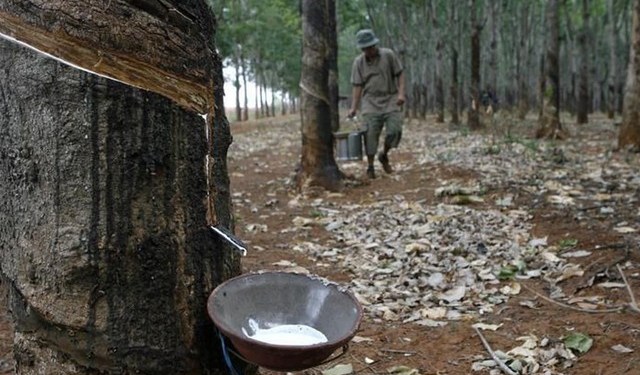Rubber export prices from Thailand, the largest producer and shipper, will probably advance through May as raw material rates surge because of a drought, said the country’s second-biggest producer.
“Latex prices are rising at a much faster pace than rubber sheet, which is unusual,” said Bundit Kerdvongbundit, vice president of Von Bundit Co. based in Phuket, Thailand. “Buyers are accelerating purchases in anticipation of shortages during wintering,” he said in a phone interview on March 20. Latex is a milky fluid produced by rubber trees.
Futures in Tokyo rallied from the lowest level since 2012 in February amid concern drought inSoutheast Asia will cut supplies. Production in Thailand, Indonesia and Malaysia may drop 6 percent to 8 percent this year because of exceptional dry weather, according to the International Rubber Consortium. The group represents the three countries and accounts for 70 percent of global supply. Wintering typically takes place from February to May when there is a seasonal drop in latex output.
The low-production cycle may last longer than usual, said Somjit Sikrinmas, the director of Songkhla Central Rubber Market. “This will boost prices further,” he said in an interview from Hat Yai on March 19.
Latex in Songkhla, a southern province, climbed 30 percent to 67 baht ($2.07) a kilogram last week from 51.50 baht on Feb. 7, the lowest level since July 2009, according to the Rubber Research Institute of Thailand. That compares with an 8 percent increase in export prices of ribbed smoked sheet to 73.95 baht on March 21 from 68.50 baht on Feb. 6, the lowest since 2009.
Global Glut
“Rising latex prices are a sign that prices of rubber sheet will follow,” said Bundit. The increase in export rates will be limited by ample global stockpiles, he said. World production will outpace demand by more than 241,000 tons in 2014 for a fourth consecutive year of glut, according to the Singapore-based International Rubber Study Group.
Futures on the Tokyo Commodity Exchange, a global benchmark, settled at 234.7 yen a kilogram ($2,298 a ton) on March 20. That’s a 12 percent increase from the 18-month low of 210 yen on Feb. 6. Markets in Japan were closed on March 21.
Drought is significant across Thailand, with the exception of a small area in the west-central region, said Donald Keeney, senior agricultural meteorologist at Gaithersburg, Maryland-based MDA Weather Services. Rains through the weekend will be temporary and not significant enough to reduce long-term drought, he said in an e-mail on March 19.
“It takes about two to four weeks for supply to decline after drought conditions occur,” said Bundit. “There will be a lack of rubber for processing plants.”
Output in Thailand may total about 4 million tons this year, little changed from 2013, as wintering losses are compensated by new plantations, according to Chaiyos Sincharoenkul, the president of Thai Rubber Association.
Supplies of rubber sheet in Songkhla have plunged by half, driving up latex prices, said Somjit of the Central Rubber Market. About 2,402 tons of sheets were sold on March 1-18 from 4,795 tons in the same period a month earlier, he said.
Source: Bloomberg



























